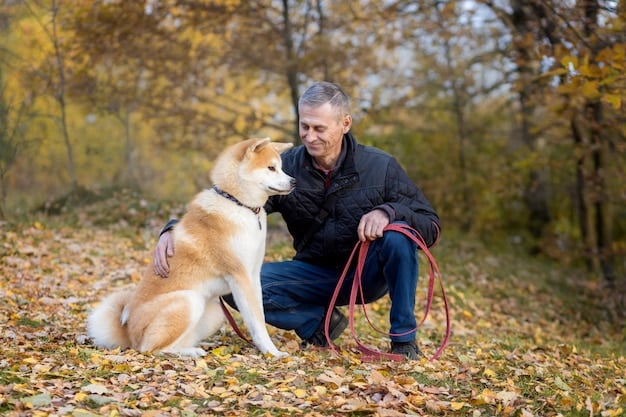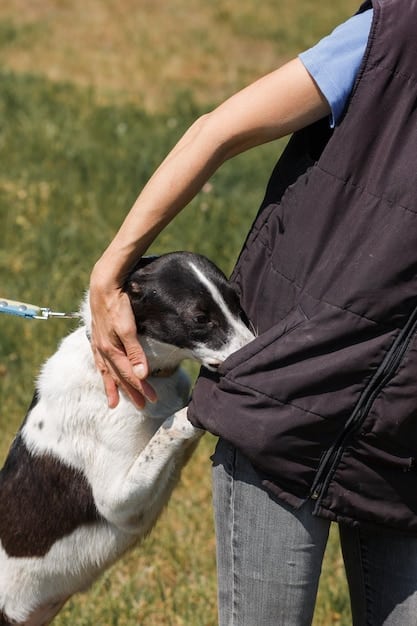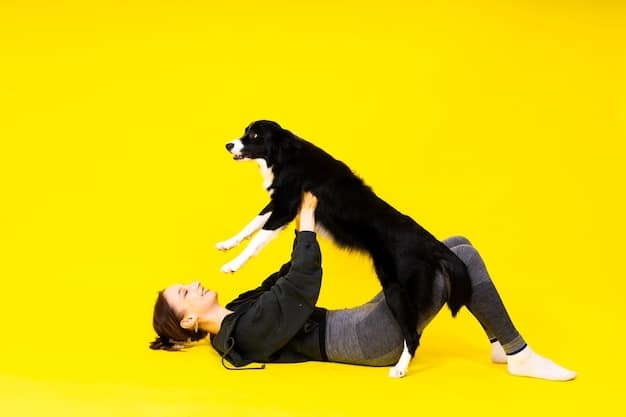Leash Reactivity Rehab: Transform Walks in 30 Days

Leash reactivity rehab is a structured approach to help dogs overcome unwanted behaviors like barking, lunging, and pulling when on a leash, transforming stressful walks into enjoyable experiences through consistent training and positive reinforcement over approximately 30 days.
Is your dog turning peaceful walks into a stressful event filled with barking, lunging, and pulling? Leash reactivity rehab: Turn walks into a positive experience in 30 days is possible with the right approach.
Understanding Leash Reactivity
Leash reactivity is a common issue among dogs, often manifesting as excessive barking, lunging, or pulling when encountering other dogs, people, or even cars while on a leash. Understanding the root causes of this behavior is the first step in effectively addressing it.
Common Causes of Leash Reactivity
Leash reactivity isn’t simply disobedience; it’s usually rooted in specific emotional responses. Here are a few common triggers:
- Fear: A dog might react aggressively out of fear of the unknown or perceived threats.
- Frustration: Being restricted by a leash can amplify a dog’s frustration when they can’t greet or investigate something interesting.
- Anxiety: Some dogs experience anxiety in new environments or around unfamiliar stimuli, leading to reactive behaviors.
Differentiating Leash Reactivity from Aggression
It’s crucial to distinguish between true aggression and leash reactivity. Reactive dogs aren’t necessarily aggressive; their behavior is often triggered by the constraints of the leash and the inability to engage naturally.
In summary, understanding that leash reactivity stems from underlying emotions like fear, frustration, or anxiety, rather than inherent aggression, is critical for choosing the right training methods. By addressing these root causes with compassion and consistency, you can help your dog overcome their reactivity and enjoy calmer, more pleasant walks.

Setting Up a 30-Day Rehab Plan
A successful leash reactivity rehab requires a well-structured plan. This 30-day program is designed to gradually expose your dog to triggers while building positive associations and promoting calm behavior.
Assessing Your Dog’s Reactivity Level
Before starting any training, assess your dog’s reactivity level. This involves identifying the triggers that cause the most intense reactions and understanding your dog’s body language when reacting.
Creating a Safe Training Environment
The initial stages of rehab should take place in a safe, controlled environment where you can minimize exposure to triggers. This could be your backyard, a quiet park during off-peak hours, or an indoor training facility.
- Start with Distance: Begin by maintaining a significant distance from potential triggers, gradually decreasing the distance as your dog progresses.
- Use High-Value Rewards: Employ treats or toys that your dog finds incredibly motivating to create positive associations.
- Keep Sessions Short: Training sessions should be brief and focused to avoid overwhelming your dog.
Remember, a well-structured 30-day plan, customized to your dog’s reactivity level and executed in a safe environment, sets the foundation for a successful rehab journey. Consistency, patience, and positive reinforcement are essential throughout the process.
Essential Training Techniques
Effective leash reactivity rehab relies on proven training techniques that address the underlying emotional responses driving the behavior. These methods focus on building positive associations, redirecting attention, and promoting calm responses.
Counter-Conditioning and Desensitization
Counter-conditioning involves changing your dog’s negative emotional response to a trigger into a positive one. Desensitization, on the other hand, gradually exposes your dog to the trigger at a low intensity, increasing the intensity as they become more comfortable.
The “Look at That” Game
This simple yet powerful game involves rewarding your dog for looking at a trigger and then immediately looking back at you. This helps create a positive association with the trigger and redirects their attention.
- Identify the Trigger: Spot the trigger (e.g., another dog) at a distance where your dog is aware but not reactive.
- Mark and Reward: As soon as your dog looks at the trigger, say “Yes!” or click, and immediately reward them with a treat.
- Repeat: Repeat this process, gradually decreasing the distance to the trigger as your dog becomes more comfortable.
Redirection and Focus Exercises
Teaching your dog to focus on you on command is crucial for redirecting their attention away from triggers. Exercises like “Watch Me” and “Leave It” can be invaluable in managing reactivity.

By consistently applying these training techniques, you can help your dog develop positive associations with triggers, redirect their attention when needed, and ultimately, reduce their reactivity on the leash. Remember, patience and consistency are key to success.
Managing Walks in the Real World
While controlled training environments are essential, real-world walks present unique challenges. Equipping yourself with strategies to manage these situations is crucial for maintaining progress and ensuring your dog’s safety and well-being.
Avoiding Trigger Stacking
Trigger stacking occurs when a dog is exposed to multiple stressors in a short period, leading to an exaggerated reactive response. Avoid crowded areas or times when multiple triggers are likely to be present.
Using the Right Equipment
The right equipment can make a significant difference in managing leash reactivity. Consider using a front-clip harness or a head halter to provide better control and prevent pulling.
- Front-Clip Harness: This type of harness redirects your dog’s attention back to you when they pull, making it easier to manage their movements.
- Head Halter: A head halter provides gentle control over your dog’s head, allowing you to redirect their focus more effectively.
- Leash Length: Use a shorter leash in areas where triggers are likely to be present to maintain better control.
Reading Your Dog’s Body Language
Becoming adept at reading your dog’s body language is essential for anticipating and managing reactive episodes. Look for early signs of stress, such as lip licking, yawning, or whale eye (when you can see the whites of their eyes).
Effectively managing walks in the real world requires a proactive approach, including trigger avoidance, appropriate equipment, and keen observation of your dog’s body language. By implementing these strategies, you can navigate challenging situations and maintain progress in your dog’s rehab journey.
Troubleshooting Common Challenges
Even with a well-structured plan, you may encounter challenges during leash reactivity rehab. Understanding these common obstacles and how to overcome them is essential for staying on track and achieving long-term success.
Plateaus in Progress
It’s normal to experience plateaus where your dog’s progress seems to stall. Don’t get discouraged! Re-evaluate your training approach and consider making adjustments to keep things engaging and challenging.
Setbacks and Reactive Episodes
Setbacks are inevitable. If your dog has a reactive episode, don’t punish them. Instead, analyze the situation to identify the trigger and adjust your training plan accordingly.
- Increase Distance: If a reactive episode occurs, increase the distance from the trigger in future training sessions.
- Simplify the Exercise: Break down the training exercise into smaller, more manageable steps.
- Consult a Professional: If setbacks persist, consider consulting a certified dog trainer or behaviorist for personalized guidance.
Dealing with Overstimulation
Overstimulation can lead to reactive behavior and hinder progress. Recognize the signs of overstimulation, such as panting, pacing, or an inability to focus, and take steps to reduce your dog’s exposure to triggers.
Troubleshooting common challenges in leash reactivity rehab requires adaptability, patience, and a willingness to seek professional guidance when needed. By addressing setbacks constructively and adjusting your approach as necessary, you can overcome obstacles and achieve lasting results.
Long-Term Maintenance and Prevention
Leash reactivity rehab isn’t a one-time fix; it requires ongoing maintenance and prevention strategies to ensure long-term success. Incorporating these practices into your daily routine will help your dog maintain their calm demeanor and prevent future reactive episodes.
Reinforcing Positive Behaviors
Continue to reinforce positive behaviors, such as calm walking and focus on you, with rewards and praise. Regular reinforcement will solidify these behaviors and make them more likely to occur in various situations.
Continuing Exposure to Triggers
Don’t completely avoid triggers! Continue to expose your dog to them in a controlled manner to maintain their desensitization and prevent relapse. Gradually increase the intensity of the triggers as your dog becomes more comfortable.
- Vary the Environment: Practice walking in different environments with varying levels of stimulation.
- Introduce New Triggers: Slowly introduce new triggers to expand your dog’s comfort zone.
- Maintain Consistency: Stick to your training routine and consistently reinforce positive behaviors.
Seeking Professional Guidance
Consider scheduling occasional check-ins with a certified dog trainer or behaviorist to ensure that you’re on the right track and address any emerging issues promptly. Professional guidance can provide valuable insights and support.
| Key Point | Brief Description |
|---|---|
| 🐕🦺Understanding Reactivity | Recognize that reactivity often stems from fear or frustration, not aggression. |
| 🐾Controlled Environment | Start training in a quiet space with minimal triggers to build confidence. |
| 🦴Positive Reinforcement | Use treats to reward calm behavior and create positive associations with triggers. |
| ✅Consistent Training | Regular, short sessions are more effective than infrequent long ones. |
FAQ
▼
Leash reactivity is when a dog displays exaggerated behaviors like barking or lunging on a leash, often due to frustration, fear, or overexcitement when they can’t approach something.
▼
While this guide focuses on a 30-day plan, the actual duration can vary depending on the dog’s reactivity level, consistency of training, and individual learning pace.
▼
No, punishment can worsen reactivity by increasing fear and anxiety. Positive reinforcement, like treats and praise, is more effective for changing a dog’s emotional response.
▼
A front-clip harness or head halter can provide better control and help redirect your dog’s attention. Consult a trainer to choose what’s best. Avoid choke-chains.
▼
If you’re struggling to manage your dog’s reactivity or if it’s escalating despite your efforts, consult a certified dog trainer or behaviorist for personalized support and guidance.
Conclusion
By understanding the root causes of leash reactivity, implementing effective training techniques, and managing walks in the real world, you can help your dog overcome their reactivity and enjoy calmer, more pleasant walks. Remember, patience, consistency, and positive reinforcement are key to success.





